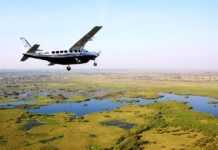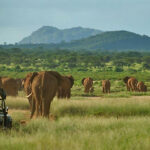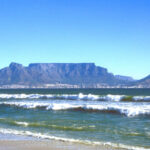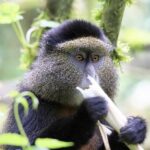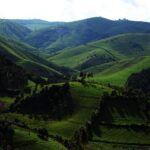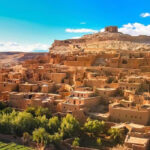The Mamumu post explained how we funded the cost of digging a well to provide year round water for the nursery of indigenous trees that Alphonce had established next to his house at Ivakale on the northern edge of Kakamega Forest.
This final post in the series will tell two stories. The first concerns the “official opening” of the well . The second tells of the results of our negotiations with one of the landowners who had indicated his willingness to sell us his plot adjacent to the forest.
First, the well opening ceremony.
Alphonce and I decided to mark the occasion of the well becoming operational with an official opening. We decided to plant some of the trees surviving from the nursery near the well and more alongside the roadside at Ivakale market outside Alphonce’s office.
During the preceding weeks, we had been pressing ahead with incorporating a company to act as the vehicle for our proposed land purchase. By this time we had made contacts in Kakamega, in particular a well known activist and campaigner for women’s rights and community engagement, who accepted our invitation to become a director of our company. It made sense to introduce Bibiana Khamete Andabwa to the Ivakale community at the well opening ceremony. So it was that four of us, including another friend living nearby in Kakamega, Carol, shared a taxi to Ivakale on the appointed day, Saturday April 18.
Bibiana and Carol at the ceremony
Alphonce met us at the office and we made our way, along with some local residents, to the well. We were joined by the village elder, Charles Shikongo.
Charles, the area elder, introduces the event
One of the other Mamumu committee members, Hutson, agreed to act as the interpreter from Luhya to English and vice versa when first Alphonce, then I, said a few words. Alphonce recounted how the lack of a water supply had not only severely restricted the number of seedlings he could propagate, but had caused a large number of the seedlings which had been germinated to perish from drought.
I explained my motivation in funding the project by drawing attention to the unique importance of Kakamega Forest, as the only sizeable surviving tract of tropical lowland forest left in Kenya which plays a critical role in helping maintain the rainfall cycle.
Hutson played a vital role as translator
I said I was pleased to be able to plant the first trees from the nursery and wanted to dedicate trees, both at the well and the market, to each of four people who have been inspirational in my life for the same two reasons. The first reason was having a passion for conserving the environment, especially plants and trees, and for sharing that passion with other people. The second reason is the interest all four people have shown for inspiring young people about the beauty and importance of the environment. These four people are
– my mother, long deceased but fondly remembered, indeed revered, who had a passion for botany and led a selfless life devoted to her family and who was happiest when sharing her love of the Scottish countryside with her husband and four children
– Wendy Aubrey whom I have known since 1980 when we met as volunteers on an expedition to Sri Lanka to live in a village and help build a road; and who has since achieved a 1st class Masters degree in Education for Sustainable Development and dedicated her life to international development especially in education and agriculture
– Margaret Watson who took me under her wing as a boy and nurtured in me a deep interest in birds and plants, especially by taking me on numerous excursions of the Edinburgh Natural History Society of which she was President for several years and
– Malcolm Porteous, school principal, who devoted his weekends for over fifteen years to leading outings for children to places rich in birdlife in eastern Scotland, thereby inspiring a love and appreciation of the environment in hundreds of children.
Before we commenced the tree planting, Alphonce demonstrated using the well by hoisting up some buckets of water to fill the watering can.
The first tree, Zanthoxylum Gilletii, (East African Satinwood or Shikhuma in Luhya) was for my mother
The second tree, Spathodea Campanulata (Nandi Flame or Mutsulio) was for Wendy, since it is noted for attracting bees
The third tree Olea Capensis (Black Ironwood or Mutukuyio) was for Margaret. In maturity, it achieves a height in excess of 50 metres, the tallest of all Kakamega’s trees.
And the fourth, Croton Macrostachys (Large leaved Croton or Musutsu) was for Malcolm. Its flowers also attract bees.
Once I had planted these trees, everyone else in the group planted some more and then we walked back to the marketplace with a wheelbarrow transporting the seedlings for planting there.
After we had planted more trees there, the event was rounded off with snacks and juice in the office.
Bibiana took the opportunity to express her appreciation from her perspective as an outsider and to observe how important it was that the community take advantage of the new well to propagate seedlings to plant in and around the forest.
The well opening ceremony marked the end of the first phase of our stay in Kakamega.
Next, an update for our ecotourism project.
Having identified a suitable plot adjacent to the forest for our lodge and confirmed that the owner, Silvanus Shikongo, brother of Charles, was interested in selling it to us, we went to the site the week before the well opening ceremony with our legal representative from Kakamega to obtain sight of the title. We succeeded in taking a copy and our lawyer was able to confirm that the land was unencumbered with no debts registered against it in the Lands Office. We met the owner’s other brother, Paul, and Silvanus’s wife, who told us we could meet him in Nairobi to negotiate the price.
Here we rejoin the narrative at the end of the previous post which left off in Naro Moru. From there, we went by matatu to Nairobi and checked in at the United Kenya Club for a three nights stay.
This venerable institution has been operating since 1946 and exudes a calm, comfortable yet modest ambience. It is situated near the Uhuru Highway close to the university and one can walk into the business centre in under ten minutes so it is ideally located. The terrace bar overlooks extensive gardens.
We spent Saturday exploring downtown and after lunch on Sunday was the appointed time to meet Silvanus Shikongo. He turned up with not only his wife whom we had meet at Ivakale, but two of his sons, both of whom are accountants, albeit one a trainee. Clearly the family meant business.
Silvanus opened by outlining three options:
- a) the family could lease the land to us
- b) we could enter into an arrangement whereby we could share in the profits from any development
- c) the family could sell us the land.
We had already turned down option (a) in December and the pitfalls of option (b) had been made painfully clear to us by Daniel on Mt Kenya three days earlier. I said we were resolved to go for option (c) in order to avoid any complications.
The African custom is for a seller to first indicate his opening price, which it is assumed is open to negotiation. On this occasion, since the initiative really had come from us, because Silvanus had been informed of our interest in the area after our first visit at the end of February, he asked us to make an offer first.
The plot is 1.3 acres and we had calculated that the annual surplus from the sugar cane harvest was in the region of KShs 70k. So we offered £KShs 350k (£2,500) equating to five years profits. After I named the figure, there was an almost audible intake of breath from the other four seated around the table. James, as planned, went through in detail how we had arrived at our estimate of 70k per year, being the surplus after deducting costs from the income from the sale of sugar cane. I added that the value of the land should be based upon its current agricultural usage. It would not be appropriate to consider any change of use leading to a higher (or lower) valuation. I said that the costs and potential benefit accruing from any change of use were entirely the responsibility and business of the buyers. For instance, we might be planning to erect a rocket launchpad which could make the site very valuable. Alternatively, we might have in mind a chapel, in which case the value of the land in terms of income would be next to nothing. Additionally, any investment in tourism at the moment must be seen as high risk due to the well known security problems.
All of this clearly came as a shock to the family who had been expecting a loaded, naive muzungu (white foreigner) to make a sky high offer because money would be no object. Silvanus opened by confessing that on the basis we had used, the price was reasonable but that he could not accept that basis. The future opportunities of our tourism project, which of course was no secret, needed to be taken into account. His eldest son added that there was likely to be a significant hike in land values in the area because the forest is about to be designated a national park. There could be compulsory purchase orders attendant upon redefining the forest boundary. He alluded to the compensation recently awarded to landowners along the route of the new Nairobi railway which were in the order of ten times the market value.
Silvanus next said he had paid KShs 700k for the land and had had to pay an additional KShs 150k to have it properly registered in 2011 and so the cost to him had been KShs 850k. After the period of four years since then and in view of what his son had said, he considered that KShs 2.5million (nearly £18,000) would be a fair offer. I shall gloss over whether or not all this made much sense to us……
In contemplating and planning this meeting over the preceding week, we had speculated on what the opening expectation would be. I thought it would range from KShs 1 to 1.5million. James and our lawyer thought it would be lower than that. We had done our research and found out that the going rate locally was somewhere between KShs 350 and 500k per acre. Although we were prepared to increase our offer from KShs 350k, it was going to be to a figure somewhere quite a long way beneath 1million. Thus if Silvanus was starting at 2.5million without any justification, having accepted that there was a valid basis for our offer, it was immediately plain to us that he was not seriously interested in selling at all. There was therefore no point in us putting forward a slightly increased offer either at the time or at any future date.
The transaction was dead in the water.
It was not the best way to end our six months exploratory venture but we are not disheartened. In the three weeks since then, another plot, somewhat larger, has become available at what may turn out to be a fair and reasonable price. We shall have to wait and see.
Meantime, until September, I am back in the UK and James is spending much of his time back home in Uganda. By the time of my anticipated return at the end of September, we should have not only incorporated our company, but also I should be (almost) in possession of an investor’s visa which will entitle me to participate in a trading business and secure the right of residency there.
Farewell from both of us till then.

